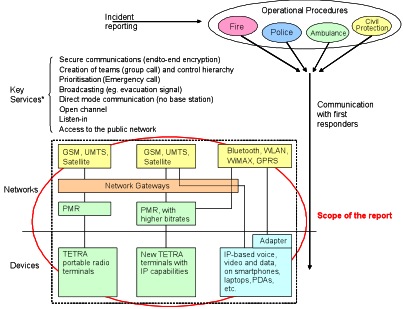| Market study of public safety communications | | Print | |
|
Public Safety Communications stakeholders have fundamental, potentially life-saving decisions to make when considering the evolution of their networks. The existing system (TETRA/PMR), whilst not universally deployed across Europe, is the most widely deployed of the technologies for the community and meets the prime considerations of being reliable, trusted and secure. The features of the terminals and the associated operational procedures are familiar to all users. However, the system can support only basic voice and low-speed data services.
Furthermore, at the operational level, despite the widespread deployment of TETRA, there is little intercommunication between first responders from the different services (police, fire, ambulance, civil protection), due to the distinct procedures and command structures - even within the same region. Similarly, there is no consideration of interoperability between regions (even for the same service). The recent report from the National Emergency Communications Plan (Homeland Security, August 2008) recommends a closer collaboration between the services, both for operational procedures, data sharing and equipment purchasing. This recommendation is also applicable to Europe and would bring cost benefits and a more flexible use of human and technical resources. The risk-free choice today would be to move faster towards a pan-European TETRA Release 2 deployment in all services, thereby minimizing CAPEX costs through the increased purchasing power of a larger marketplace, and minimizing OPEX costs by retaining the well-known procedures currently in place in the majority of regions. Parallel actions should be undertaken to: - encourage more interoperability and commonality of procedures and services between the different emergency services and between regions, and - contribute to the spectrum review process in order to ensure more bandwidth for Public Safety Communications, by reserving some of the radio spectrum becoming available as analogue broadcast television migrates to digital [by the end of 2012], in the release of bandwidth known as the 'digital dividend'. However, in certain situations (eg. fire in a tunnel, monitoring vital life signs, viewing road traffic conditions), the benefit of having live inputs from additional sources, such as sensors and cameras has been demonstrated. Data and video from such sources can be integrated more easily into IP-based systems, and the visualisation requires terminal displays with high quality graphical capabilities (eg. laptops). Also, a wireless IP network (Mobile Access Router) can also be easily brought into an area having no connectivity, and backhauled to the nearest surviving network. In the U.S., tens of billions of dollars are expected to be spent each year on new wireless broadband networks, devices and applications for the Public Safety market. The integration of such new features in Europe is likely to be region-specific and a very gradual process, all the time ensuring compatibility with the existing networks and terminals. The Packet Data Optimised feature in TETRA is a key enabling feature for the interoperability. Such innovation demands new IT skills and operational procedures. Also, the management of this new information (maintenance, collection, storage, configuration, processing, distribution to the relevant vehicles/persons, etc.) requires new skills and processes. Public-private partnership trials should be investigated as means of introducing new technologies, since the cost will be less and the necessary technical skills will be brought in by the vendors. Advanced IP communications, wireless networks and integrated security technologies are now being offered by many manufacturers as Public Safety networking solutions. Several trials are currently in progress. A more detailed report (D3.13) can be downloaded from the restricted documents section.
|
